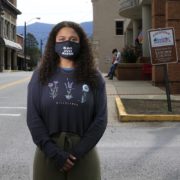In the wake of this year’s nationwide protests against institutional racism, Black Appalachians have found an opportunity for their history and struggles to be recognized more widely.
— The Associated Press, NBC News
LOUISVILLE, Ky. — Dayjha Hogg has known racism her entire life, but until recently she thought she and her family had to face it on their own.
Hogg, 19, lives in Whitesburg, Kentucky, a town of 2,000 people in the heart of Appalachia. She is biracial — born to a Black father and a white mother — and can recall times when she and her brothers were targets of racial slurs, suspicious glances and rude comments.
But in the wake of this year’s nationwide protests against institutional racism — sparked by George Floyd’s killing in Minnesota — Black Appalachians have found an opportunity for their history and struggles to be recognized more widely. Though the national reckoning on racism has raised awareness about the issue for many white Americans, that it is also echoing in the hills of Appalachia is particularly striking in a region that isn’t known for its diversity.
— Credits & Context
Featured Image, Brian Blanco / AP file
Full article @ NBC News
Appalachia
Appalachia is a cultural region in the Eastern United States that stretches from the Southern Tier of New York State to northern Alabama and Georgia. While the Appalachian Mountains stretch from Belle Isle in Canada to Cheaha Mountain in Alabama, the cultural region of Appalachia typically refers only to the central and southern portions of the range, from the Blue Ridge Mountains of Virginia, southwesterly to the Great Smoky Mountains. As of the 2010 United States Census, the region was home to approximately 25 million people.
Since its recognition as a distinctive region in the late 19th century, Appalachia has been a source of enduring myths and distortions regarding the isolation, temperament, and behavior of its inhabitants. Early 20th century writers often engaged in yellow journalism focused on sensationalistic aspects of the region’s culture, such as moonshining and clan feuding, and often portrayed the region’s inhabitants as uneducated and prone to impulsive acts of violence. Sociological studies in the 1960s and 1970s helped to re-examine and dispel these stereotypes.
While endowed with abundant natural resources, Appalachia has long struggled and been associated with poverty. In the early 20th century, large-scale logging and coal mining firms brought wage-paying jobs and modern amenities to Appalachia, but by the 1960s the region had failed to capitalize on any long-term benefits from these two industries. Beginning in the 1930s, the federal government sought to alleviate poverty in the Appalachian region with a series of New Deal initiatives, such as the construction of dams to provide cheap electricity and the implementation of better farming practices. On March 9, 1965, the Appalachian Regional Commission was created to further alleviate poverty in the region, mainly by diversifying the region’s economy and helping to provide better health care and educational opportunities to the region’s inhabitants. By 1990, Appalachia had largely joined the economic mainstream, but still lagged behind the rest of the nation in most economic indicators.
Source – Appalachia (Updated: 14 September 2020) Wikipedia. Available at https://en.wikipedia.org/wiki/Appalachia (Accessed: 01 October 2020)

